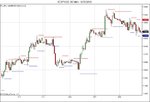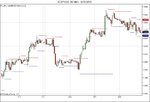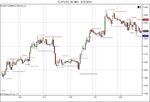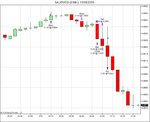Adamus
Experienced member
- Messages
- 1,898
- Likes
- 97
Lessons from the data
Just ran a comparison of a simple pivot-point system trading 6 months with different historical data.
Just to make it not so heavily dependent on precise tick-by-tick data, I ran the test on hourly bars.
First I used IB historical data, freshly downloaded from their server.
Total number of trades: 127.
Profit per trade: -$147
Then I deleted the IB data and reloaded it from the IQFeed server:
Total number of trades: 123
Profit per trade: -$123
And last I deleted the IQFeed data and loaded up the tickdata from Disktrading:
Total number of trades: 111
Profit per trade: -$58
I've included charts of the different data, for 6 days with the pivot point indicator. The first is the IB data, the second is the same window, but with IQFeed data. The IQFeed data is missing two of the support pivot points - just in case anyone out there is bored and wants to play "spot the difference".
Just ran a comparison of a simple pivot-point system trading 6 months with different historical data.
Just to make it not so heavily dependent on precise tick-by-tick data, I ran the test on hourly bars.
First I used IB historical data, freshly downloaded from their server.
Total number of trades: 127.
Profit per trade: -$147
Then I deleted the IB data and reloaded it from the IQFeed server:
Total number of trades: 123
Profit per trade: -$123
And last I deleted the IQFeed data and loaded up the tickdata from Disktrading:
Total number of trades: 111
Profit per trade: -$58
I've included charts of the different data, for 6 days with the pivot point indicator. The first is the IB data, the second is the same window, but with IQFeed data. The IQFeed data is missing two of the support pivot points - just in case anyone out there is bored and wants to play "spot the difference".
Attachments
Last edited:




